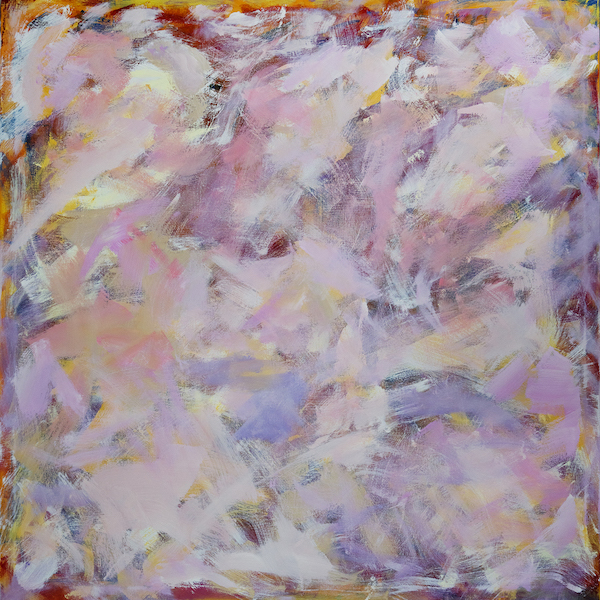Abbott Stillman Makes the Transition from Developer to Painter
Abbott Stillman’s paintings were recently on view in New York in the group show “Urban Summer” at Georges Bergès Gallery. The abstract works in the exhibition showcased the artist’s astute sense of color, harmony, and layering. His exuberant compositions are intended to elicit an emotional reaction in the viewer—whether that be in reference to time, memory, or connections.
The exhibition also marked the first time Abbott Stillman presented his paintings to the public. While having painted since the 1980s, Stillman’s output has been more focused on real estate. He got his Masters at MIT’s School of Architecture and Planning before working at development companies in South Carolina, California, and Connecticut. In the late 1970s, he and his father established The Stillman Group, developing millions of square feet of buildings, including Three Lincoln Center and 1110 Vermont Avenue. All the while, he was quietly painting at home, moving from still lifes and portraits to abstraction, influenced by the work of Bacon, Rothko, Matisse, Cézanne, and more.
As Abbott Stillman slowed down his career in development, he’s now ready to focus solely on his art and process. At the heart of that process is a desire to connect, above all else. Whitewall spoke with Abbott Stillman about this major professional transition, as well as why he still believes art can change hearts and minds.
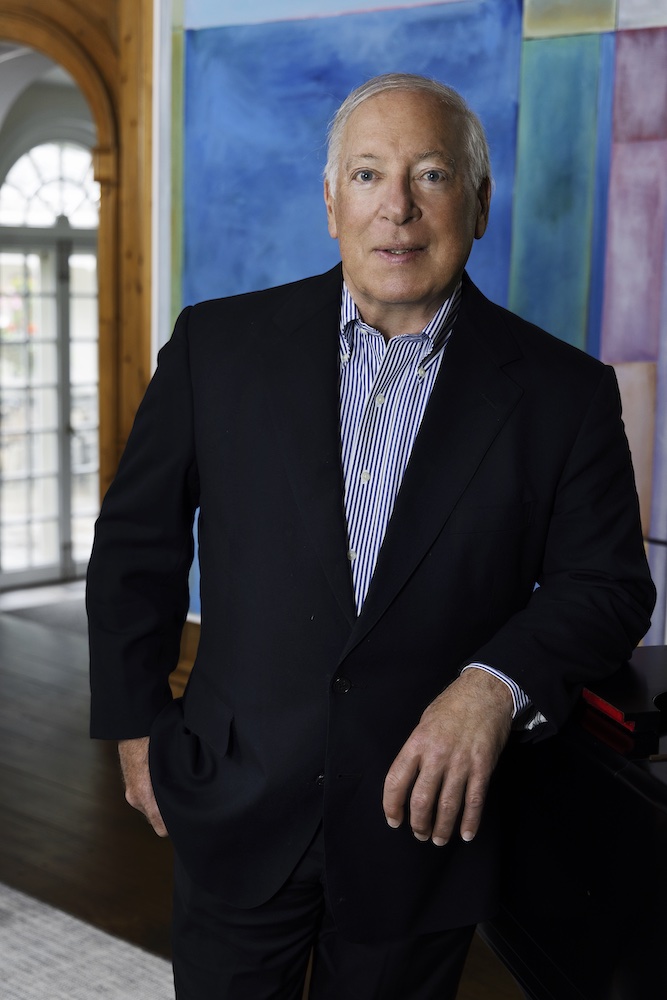
Abbott Stillman, portrait by Steve Benisty.
WHITEWALL: Can you tell us about your works recently on view in “Urban Summer” at Georges Bergès Gallery in New York?
ABBOTT STILLMAN: There are six paintings. Four are a series, “The Seasons,” and include Winter’s Tale, Spring Deep, Summer Meander, and Autumn Ambiguities. The other two are Blood Orange II and Via dei Condotti.
The first four are about the passage of time, took almost a year to paint, and are highly dependent upon the buildup of layers of paint in order to get colors and tones just right. My hope is that while they look very good at a distance, as the viewer approaches some of the details and gestures become more obvious and the “tale” in Winter’s Tale catches the imagination.
Blood Orange II is obviously influenced by Rothko. I had previously explored the relationship of these particular colors, each of which I believe can carry an incredible amount of nuance. In this version, I used the vertical lines to both create a relationship of colors and to also create a sense of composition that particularly appeals to me.
Via dei Condotti is inspired by the Roman street of that name. My wife and I adore Rome and have on occasion stayed at the Inn at the Spanish Steps just off the Piazza di Spagna. One Sunday in October we witnessed vast crowds of Romans parading up and down Via dei Condotti right past our hotel, most of the men dressed in white suits and hats, the women wearing beautiful dresses and a lot of jewelry. It was an image I will never forget. I tried to capture the feeling in this painting.
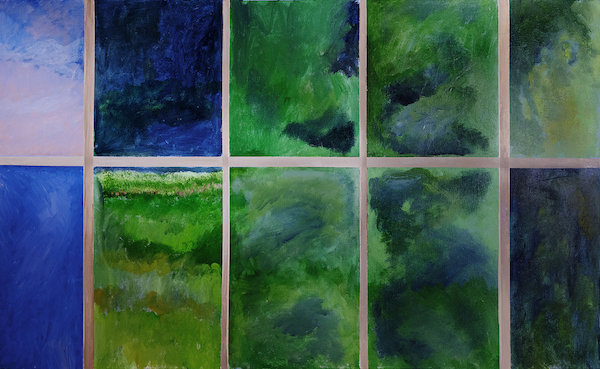
Abbott Stillman, “Landscape John’s Island,” 2018, acrylic on canvas 60 x 36 inches, courtesy of the artist.
WW: Was there a particular starting point for “The Seasons”?
AS: The Seasons “started” with two inspirations. I was together with my extended family and took note of the fact that all of my children were now true adults with their own children, and was thrown into a philosophical space in which I became very much aware of the passage of time and how important it is to connect to those you love.
One of my core philosophies is one I took from my early reading of E.M. Forster‘s Howards End which starts with the frontispiece “Only Connect!” That philosophy is deeply ingrained in my work. In any case, that day with my family struck hard at me and almost overwhelmed me with a sense of the seasons succeeding each other endlessly. Later that day I listened to Vivaldi‘s Four Seasons on Spotify and 10 minutes later I was in my studio starting “The Seasons.”
WW: This is your first time showing your work publicly, while you’ve been painting since the 1980s. What made you want to show your work for the first time?
AS: To be honest, to some extent, I was simply carried by the momentum created by others. For many years friends and acquaintances, many with experience in the art world, had urged me to show the work and make it available for sale to others. I had always responded that I enjoyed painting for the sake of painting and was too busy with other activities to allocate time and effort to expanding the audience for what I was doing.
But then a friend asked if he could take some pictures of my work, to which I readily acceded. He, in turn, showed them to Georges Bergès, who in turn found them interesting enough and arranged to come and see my studio and have lunch with me.
“I still believe that art can change hearts and minds,” — Abbott Stillman
At the same time, I was becoming more chagrined at the state of the culture in America and felt more and more compelled to “say something.” Perhaps I’m being naïve, but I still believe that art can change hearts and minds, and I wanted to at least contribute to those trying to glue things together when it certainly appears “the center cannot hold.” So, I was open to the idea of sharing my vision and happily accepted Georges’s invitation to become a featured artist in his next group show.
I do not intend to sound completely unselfish. I am ambitious and now strongly desire to create a legacy that my family can look to for generations. Having decided to become a “professional” artist, I want to be counted among the best and the only way to do that is to show what you’ve done, and do it as often as possible.
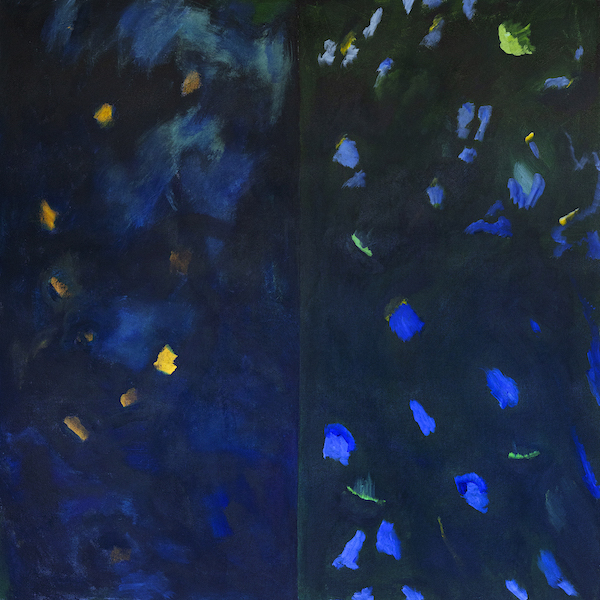
Abbott Stillman, “Origins ll,” 2023, acrylic on canvas 60 x 60 inches, courtesy of the artist.
WW: What drew you to painting early on?
AS: I’ve also done some lost wax sculpting, but I absolutely love working with color and painting certainly lends itself to that. I toyed with the idea of working in the same medium as Dan Flavin (fluorescents) or Murray Schwartz (diachronic glass) but what I loved about painting in particular was the opportunity to add and subtract, to keep working each piece until you feel you’re done, and the fact that the canvas is tangible.
I always loved that what I created as a developer/builder was something you could reach out and touch. As many forms of work became more and more detached from materiality and became digitized and living in some metaverse I found myself more interested in touch and feel. I like the materiality of a canvas with various layers of paint on it.
“I always loved that what I created as a developer/builder was something you could reach out and touch,” — Abbott Stillman
WW: What prompted your interest in abstraction?
AS: I had been working largely on portraits and still-lifes and began to feel that having really studied Cézanne, what was the point of anyone painting another still life, and my portraits had veered a bit toward Francis Bacon-like grotesques and neither really felt authentic to me. I was in the midst of a very fecund part of my career and my family life and was actually feeling that I had a lot to say and could much better say it if I moved to abstraction.
There were three artists whose experience helped me make the leap without looking back. The first was a Hungarian artist named Gyorgy Kepes whom I worked with a bit when I was at M.I.T. in the Graduate School of Architecture and City Planning. He had switched from representational painting to both abstract and environmental art and was a strong advocate of abstraction and the use of technology in art. The other two influences were Matisse, who is probably my favorite of all artists and whose work became increasingly abstracted as his career evolved, and Richard Diebenkorn, a painter I so admire, whose work shifted from abstraction to a mix of abstraction and representation and then back to abstraction as he entered the most influential era of his work.
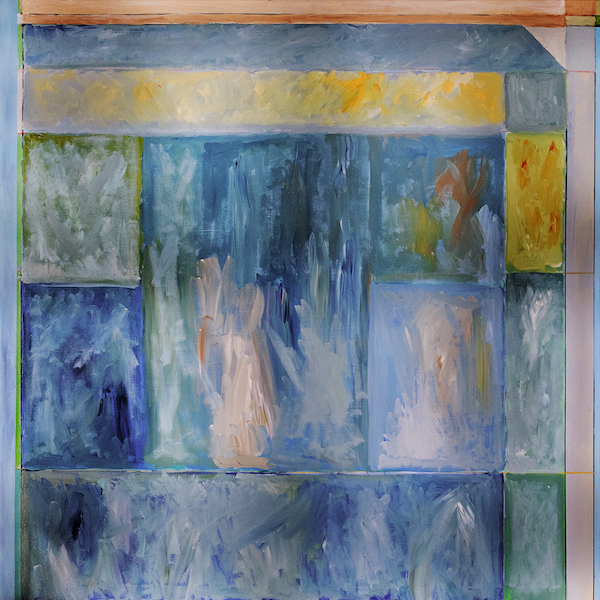
Abbott Stillman, “Blue Notes,” 2019, acrylic on canvas, 60 x 60 inches, courtesy of the artist.
WW: Where do you typically start with a painting?
AS: I start with an idea of what I intend to do but start knowing it will be a winding path to the finish and may come out quite different from my original intent. From a technical point of view, I almost always start by laying down some underpainting, much of which is intended to either only barely be seen in the end or to influence the color of the next layer of paint to be placed on top of it.
I try in most cases to create a degree of harmony in the painting and that requires certain relationships within the painting and particular structure and composition that allows for balance. There have been times when I had to sit with a painting for weeks deciding whether to change anything. In almost all cases there comes a point when my eye is satisfied and I’m sensing the emotions I want the painting to elicit from the viewer.
On rare occasions, though, I simply cannot get “settled” over a painting and I have been known to ask others (my wife, my children, a few friends, a fellow painter, etc.) to take a look. I admit to paying attention to their opinions. In one case a longstanding friend who was a gallerist made a single comment about a space on a painting and a week later, after thinking about it, I agreed with her and added a detail that took the painting from good to a lot better than good.
Inside the Artist’s Studio
WHITEWALL: Where do you paint? Do you have a studio? When do you like to paint?
ABBOTT STILLMAN: I built a beautiful studio at my house that has about 650 square feet of space, light from three sides and above, and looks out on a beautiful landscape that includes a wildflower garden and exquisite plantings that we did in the course of restoring and modernizing a house that was built in 1930.
I like to paint at different times of the day, depending upon the season and what other work I have to do that day. There are days when I don’t set foot in the studio and others when I am there for as long as six or seven hours. I generally like to paint in the morning or mid-afternoon. During the summer I only paint in the morning because I want to be outside experiencing the golden hours between 4:30-7:00 PM when the shadows elongate and the colors of everything become so sharp that you can almost feel them in your gut.
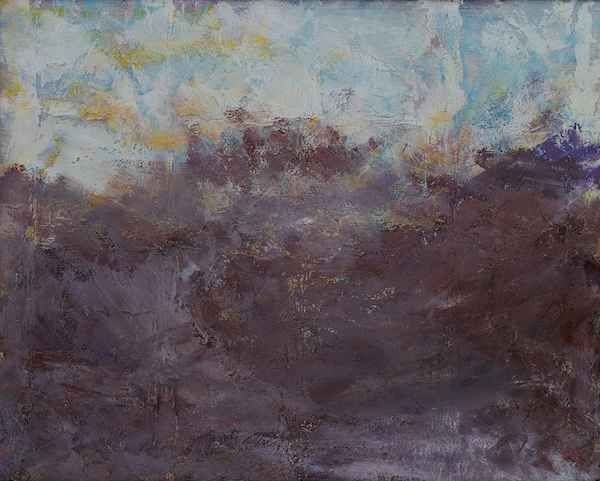
Abbott Stillman, “Rough Waters,” 2001, acrylic on canvas, 33 x 24 inches, courtesy of the artist.
WW: You’ve said that a painting moves through you, rather than from you. How do you get in the zone to let that happen?
AS: You start, and you keep working at it, and you allow your mind to relax and you keep looking at the canvas and letting it speak to you. At some point, and only when the painting is coming easily and fast and furiously, each mark, each brushstroke, leads you to the next one and you keep paying attention but with a part of your mind that isn’t working hard and you step back to look and then quickly get back into the painting still staying in that kind of only-half-conscious state.
Sometimes I use music to try to trigger that flow. Sometimes it just happens. Sometimes I cannot call upon it on demand. But when you’re in that flow it’s the greatest feeling you can experience. I’ve had it sometimes in the past, first while playing sports, later when in the design phase of my developing buildings, sometimes while writing, sometimes while I was teaching undergrads at M.I.T. and Harvard. But it comes more regularly while I’m painting and that is why I will never stop until I literally cannot pick up a brush.
WW: You compared what you do with painting to tikkun olam, the concept of putting together a fractured world. What attracts you to that notion, to that pursuit of harmony?
AS: I think everyone should be attracted to that goal. There is so much dissension, so much anger, so much tragedy in this world, so many people feeling sorry for themselves, blaming others for their unhappiness, so much knee-jerk hatred for the culture in which they find themselves, so much desire to just blow the whole thing up. I look at this life differently, and perhaps it is because I’ve lived long enough.
Each of us beats almost infinite odds to be born and have this human experience between our eternal states of mere atoms and stardust. For that we should each be beyond grateful. We should recognize the joy, and tragedy, of each of our existences and reach out to each other as fellow travelers. We should, “Only Connect!” Connect our brain to our heart, connect to each other, connect to this miraculous universe. There is, in my belief, a core harmony in this vast universe of ours. A music of the spheres.
There is a concept called “entanglement” in quantum physics. It is the fact that a pair of particles can be entangled, perfectly paired to react to each other even if they are at opposite ends of the universe. Even Albert Einstein said this was impossible, but it has been proven true. So the very core of quantum mechanics is connection. There is a harmony to life, a connection of everything to everything. I hope that harmony, that connection, and a sense of quiet satisfaction infuses my work.
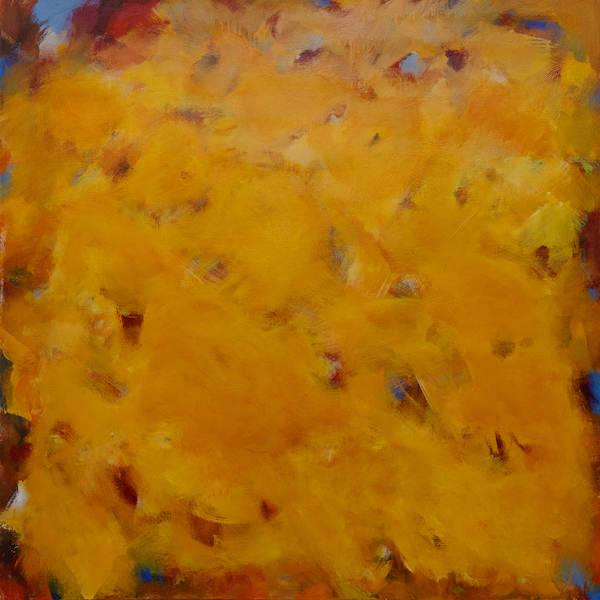
Abbott Stillman, “Autumn Ambiguities,” 2023, acrylic on canvas, 60 x 60 inches, courtesy of the artist.



